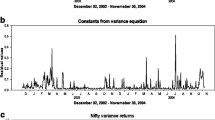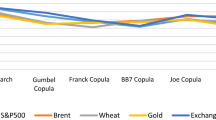Abstract
In 2007 futures contracts were introduced based upon the listed real estate market in Europe. Following their launch they have received increasing attention from property investors, however, few studies have considered the impact their introduction has had. This study considers two key elements. Firstly, a traditional Generalized Autoregressive Conditional Heteroskedasticity (GARCH) model, the approach of Bessembinder & Seguin (1992) and the Gray’s (1996) Markov-switching-GARCH model are used to examine the impact of futures trading on the European real estate securities market. The results show that futures trading did not destabilize the underlying listed market. Importantly, the results also reveal that the introduction of a futures market has improved the speed and quality of information flowing to the spot market. Secondly, we assess the hedging effectiveness of the contracts using two alternative strategies (naïve and Ordinary Least Squares models). The empirical results also show that the contracts are effective hedging instruments, leading to a reduction in risk of 64 %.


Similar content being viewed by others
Notes
To check the robustness of our baseline results, a robustness check was performed. Oct 2002 (5 years before the onset of futures trading) was selected. However, it did not change the conclusion of futures trading did not destabilise the underlying spot market.
A robustness check of the sensitivity of our results to currency denomination was also performed in which our models were re-run with the dataset in US dollar. Little variation was observed. Specifically, the baseline findings are robust in which no significant increase in volatility that is attributed to the introduction of futures trading.
Results from Augmented Dickey-Fuller and Phillips-Perron unit root tests show that all of the data is stationary. These results are available from the authors on request.
The GFC period is from September 2007–June 2009. This is consistent with the studies such as Newell (2010) and KnightFrank (2010) in which a recovery sign was evident since Q2, 2009. Robustness checks were also performed. Different periods were selected (1) Oct 07-Dec 09, (2) Sept 07-March 09 and (3) Oct 07-May 09. The robustness checks show that the preceding results are robust.
A unit root test was performed for these expected and unexpected components; the results show these variables are stationary.
Naturally, a third time dummy representing the pre-crisis period cannot be introduced as it would lead to perfect multicollinearity. Besides, the full sets of time dummy results are available from the authors.
Gulen & Mayhew (2000) do highlight the importance of accounting for movements in the world index in the consideration of changes in underlying volatility. To further control for the effect of other determinants of volatility, the FTSE Eurofirst 300 index, the FTSE Eurofirst 300 Eurozone Index as well as the S&P Global Property Index were introduced into our baseline models. Interestingly, the inclusions of these indices had little impact on our baseline results. The results also suggest that our results are robust to these alternative specifications. The full sets of results from these specifications are available from the authors on request.
Interestingly, a negative relationship is observed between the forward and spot housing markets in Hong Kong by Wong et al. (2006), confirming that futures/forwards trading may enhance the information flows and reduce spot volatility.
A robustness check with 10-day window was also performed, no significant difference was found. Thus, the baselines results are robust to the choice of estimation window. The full robustness results are available from the authors.
References
Aggarwal, R. (1988). Stock index futures and cash market volatility. Review of Futures Markets, 7, 290–299.
Andani, A., Lafuente, J. A., & Novales, A. (2009). Liquidity and hedging effectiveness under futures mispricing: international evidence. Journal of Futures Markets, 29(11), 1050–1066.
Antoniou, A., & Holmes, P. (1995). Futures trading, information and spot price volatility: evidence for the FTSE-100 stock index futures contract using GARCH. Journal of Banking and Finance, 19(1), 117–129.
Antoniou, A., Holmes, P., & Priestley, R. (1998). The effects of stock index futures trading on stock index volatility: an analysis of the asymmetric response of volatility to news. Journal of Futures Markets, 18(2), 1195–1228.
Bae, S. C., Kwon, T. H., & Park, J. W. (2004). Futures trading, spot market volatility, and market efficiency: the case of the Korean index futures markets. Journal of Futures Markets, 24(12), 1195–1228.
Bessembinder, H., & Seguin, P. J. (1992). Futures-trading activity and stock price volatility. Journal of Finance, 47(5), 2015–2034.
Bessembinder, H., & Seguin, P. J. (1993). Price volatility, trading volume and market depth: evidence from futures markets. Journal of Financial and Quantitative Analysis, 28(1), 21–39.
Bohl, M. T., Salm, C. A., & Wilfling, B. (2011). Do individual index futures investors destrablize the underlying spot market? Journal of Futures Markets, 31(1), 81–101.
Brounen, D., & Ben-Hamo, Y. (2009). Calender anomalies: the case of international property shares. Journal of Real Estate Finance and Economics, 38(2), 115–136.
Chang, E. C., Cheng, J. W., & Pinegard, J. M. (1999). Does futures trading increase stock market volatility? The case of the Nikkei stock index futures markets. Journal of Banking and Finance, 23(5), 727–753.
Chaudhry, M., Christie-David, R., & Webb, J. R. (2010). REITs: hedging and diversification possibilities. Journal of Real Estate Portfolio Management, 16(3), 217–226.
Clayton, J. (2007). Commercial real estate derivatives: the developing U.S. market. Real Estate Issues, 32(2) 33–40.
Cotter, J., & Stevenson, S. (2006). Multivariate modeling of daily REIT volatility. Journal of Real Estate Finance and Economics, 32(3), 305–325.
Cotter, J., & Stevenson, S. (2008). Modeling long memory in REITs. Real Estate Economics, 36(3), 533–554.
Cox, C. C. (1976). Futures trading and market information. Journal of Political Economy, 84(6), 129–137.
Daigler, R. T., & Wiley, M. K. (1999). The impact of trader type on the futures volatility-volume relation. Journal of Finance, 54(6), 2297–2316.
Darrat, A. F., & Rahman, S. (1995). Has futures trading activity caused stock price volatility? Journal of Futures Markets, 15(5), 537–557.
Edwards, F. R. (1988a). Futures trading and cash market volatility: stock index and interest rates futures. Journal of Futures Markets, 8(4), 421–439.
Edwards, F. R. (1988b). Does futures trading increase stock market volatility? Financial Analysts Journal, 44(1), 63–69.
EPRA. (2011). EPRA research: monthly statistical bulletin June 2011. Resource document. European Public Real Estate Association. http:www.epra.com. Accessed 24 August 2011.
Figlewski, S. (1981). Futures trading and volatility in the GNMA market. Journal of Finance, 36(2), 445–456.
Figlewski, S. (1984). Hedging performance and basis risk in stock index futures. Journal of Finance, 39(3), 657–669.
Giliberto, M. (1993). Measuring real estate returns: the hedged REIT index. Journal of Portfolio Management, 19(3), 94–99.
Gray, S. F. (1996). Modeling the conditional distribution of interest rates as a regime-switching process. Journal of Financial Economics, 42, 27–62.
Gulen, H., & Mayhew, S. (2000). Stock index futures trading and volatility in international equity markets. Journal of Futures Markets, 20(7), 661–685.
Harris, L. (1989). The October 1987 S&P 500 stock-futures basis. Journal of Finance, 44(1), 77–99.
Holmes, P. (1996). Stock-index futures hedging, duration effects, expiration effects and hedge ratio stability. Journal of Business Finance and Accounting, 23(1), 63–77.
Hoesli, M., & Lekander, J. (2008). Real estate portfolio strategy and product innovation in Europe. Journal of Property Investment and Finance, 26(2), 162–176.
Jirasakuldech, B., Campbell, R. D., & Emekter, R. (2009). Conditional volatility of equity real estate investment trust returns: a pre and post-1993 comparison. Journal of Real Estate Finance and Economics, 38(2), 137–154.
Kaldor, N. (1939). Speculation and economic stability. Review of Economic Studies, 7(1), 1–27.
KnightFrank. (2010). 2010 global real estate market: annual review and outlook. Resource document. Knight Frank. http:www.knightfrank.com/research/. Accessed 21 October 2011.
Lecomte, P., & McIntosh, W. (2006). Designing property futures contracts and options based on NCREIF property indices. Journal of Real Estate Portfolio Management, 12(2), 119–153.
Lee, C. L. (2009). Volatility transmission in Australian REIT futures. Journal of Real Estate Portfolio Management, 15(3), 221–238.
Lee, C. L., & Lee, M.-L. (2012). Hedging effectiveness of REIT futures. Journal of Property Investment and Finance, 30(3), 257–281.
Lee, S. B., & Ohk, K. Y. (1992). Stock index futures listing and structural change in time-varying volatility. Journal of Futures Markets, 12(5), 493–509.
Lenkkeri, V., Marquering, W., & Strunkmann-Meister, B. (2006). The Friday effect in European securitized real estate index returns. Journal of Real Estate Finance and Economics, 33(1), 31–50.
Liang, Y., Seiler, M. J., & Chatrath, A. (1998). Are REIT returns hedgable? Journal of Real Estate Research, 16(1), 87–97.
Liow, K. H. (2009). Long-term memory in volatility: some evidence from international securitized real estate markets. Journal of Real Estate Finance and Economics, 39(4), 415–438.
Liow, K. H., & Ibrahim, M. F. (2010). Volatility decomposition and correlation in international securitized real estate markets. Journal of Real Estate Finance and Economics, 40, 415–438.
Lizieri, C., Marcato, G., Ogden, P., & Baum, A. (2012). Pricing inefficiencies in private real estate markets using total return swaps. Journal of Real Estate Finance and Economics, 45(3), 774–803.
McKenzie, M. D., Brailsford, T. J., & Faff, R. W. (2001). New insights into the impact of the introduction of futures trading on stock price volatility. Journal of Futures Markets, 21(3), 237–255.
Newell, G. (2010). The effectiveness of A-REIT futures as a risk management strategy in the Global Financial Crisis. Pacific Rim Property Research Journal, 16(3), 339–357.
Newell, G., & Tan, Y. K. (2004). The development and performance of listed property trust futures. Pacific Rim Property Research Journal, 10(2), 132–145.
Nomikos, N. K., & Pouliasis, P. K. (2011). Forecasting petroleum futures markets volatility: the role of regimes and market conditions. Energy Economics, 33, 312–337.
NYSE. (2011). NYSE LIFFE European derivatives market: NYSE LIFFE annual & monthly statistics. Resource document. NYSE LIFFE. http://www. nyseeuronext.com/liffe. Accessed 26 September 2011.
Ong, S. E., & Ng, K. H. (2009). Developing the real estate derivative market for Singapore: issues and challenges. Journal of Property Investment and Finance, 27(4), 425–432.
Oppenheimer, P. H. (1996). Hedging REIT returns using the futures markets. Journal of Real Estate Portfolio Management, 2(1), 41–53.
Pericli, A., & Koutmos, G. (1997). Index futures and options and stock market volatility. Journal of Futures Markets, 17(8), 957–974.
Santoni, G. J. (1987). Has programmed trading made stock prices more volatile? Review-Federal Reserve Bank of St. Loius, 69(5), 18–29.
Stein, J. C. (1987). Informational externalities and welfare-reducing speculation. Journal of Political Economy, 95(6), 1123–1145.
Stevenson, S. (2000). International real estate diversification: empirical tests using hedged indices. Journal of Real Estate Research, 19(1/2), 105–131.
Stevenson, S. (2002). An examination of volatility spillovers in REIT returns. Journal of Real Estate Portfolio Management, 8(3), 229–238.
Stoll, H. R., & Whaley, R. E. (1988). Volatility and futures: message versus messenger. Journal of Portfolio Management, 14(2), 20–22.
Watanabe, T. (2001). Price volatility, trading volume and market depth: evidence from the Japanese stock index futures market. Applied Financial Economics, 11(6), 651–658.
Wong, S. K., Yiu, C. Y., Tse, M. K. S., & Chau, K. W. (2006). Do the forward sales of real estate stabilize spot prices? Journal of Real Estate Finance and Economics, 32(3), 281–293.
Working, H. (1953). Futures trading and hedging. American Economic Review, 43(3), 314–343.
Author information
Authors and Affiliations
Corresponding author
Rights and permissions
About this article
Cite this article
Lee, C.L., Stevenson, S. & Lee, ML. Futures Trading, Spot Price Volatility and Market Efficiency: Evidence from European Real Estate Securities Futures. J Real Estate Finan Econ 48, 299–322 (2014). https://doi.org/10.1007/s11146-012-9399-3
Published:
Issue Date:
DOI: https://doi.org/10.1007/s11146-012-9399-3




